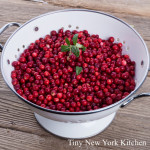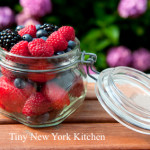Cranberries
These tart, bright ruby-red berries grow wild on evergreen shrubs in peaty marshland all over northern Europe and North America. They are closely related to blueberries and bilberries, but are much more sour and are always served cooked. They are closely related to cowberries and lingonberries.
Cranberries are sometimes known as bouceberries since they were traditionally tested for firmness by being bounced seven times. Any berries that failed the bounce test were too squashy and were, therefore, discarded. Because of their waxy skins, cranberries keep for much longer than other berries, which helps to explain their popularity.
Cranberries contain useful amounts of vitamins C and D, potassium and iron. They used to be considered to be good protection against scurvy, and they are known to contain a natural antibiotic. Cranberry juice has long been recommended as a natural remedy for cystitis, kidney, bladder and urinary tract infections.
Look for plump, firm, bright, red berries and check the base of the carton in case of squashed or shriveled berries. Fresh cranberries will keep in the refrigerator for four weeks, or freeze them in plastic bags.
Cranberries can be used in both sweet and savory dishes or can be juiced and served as a drink. Their most famous incarnation is as cranberry sauce. The berries are high in pectin, so they make excellent jams and jellies. They also combine well with orange and apple, and can be mixed with blackberries and raspberries for an autumn version of summer pudding. Cranberry sorbet is a delicious treat. When cooking them for a sweet dish, do not add the sugar until the skins have popped or they will become tough.
“Work With What You Got!”
© Victoria Hart Glavin Tiny New York Kitchen © 2016 All Rights Reserved
Care & Handling Of Berries
Strawberries: Pick strawberries at their peak of ripeness. Look for symmetrically shaped berries; a brilliant sheen and rich even red color; fresh unwilted green caps; avoid strawberries with seedy tips or white shoulders. A white “core” in your strawberries is not an indication of ripeness. The internal pigment of strawberries ranges from white to bright red and is a characteristic of the berry plant variety and not of the berries’ ripeness or flavor.
Raspberries: When choosing raspberries look for plump, evenly colored berries that have a soft and hazy gloss and are free of dents and bruises. Raspberries have tiny hairs on them called “styles.” These are a completely natural part of the fruit’s defense mechanism and do not affect the taste or ripeness of the berries.
Blueberries: Choose blueberries that are dry, plump, round and free of dents and bruises. Blueberries should have a soft , hazy white coating, which is called “bloom.” Bloom is a completely natural part of the berries’ defense mechanism and helps protect them from the harsh rays of the sun. Avoid blueberries that are shriveled or lack bloom.
Blackberries: Look for deep, evenly colored blackberries with a nice sheen. Berries that are plump and dry and free of dents or bruises. Blackberries range in color from deep blue/purple to deep purple/black. Blackberries are often two-tone in color, which is perfectly natural and does not affect ripeness.
All fresh berries are highly perishable and should be refrigerated at all times until eaten or used as an ingredient. Refrigeration will extend freshness and shelf life.
It is recommended that you wash all berries before using them. However, you should never wash your berries until just before you are ready to eat or use them, as the moisture will decrease their shelf life.
Fresh berries can be easily frozen and enjoyed until you are ready to use them.
Wash strawberries carefully in cold water and pat dry. Remove the stems and any soft spots. Pack the berries into freezable containers or freeze them on a baking sheet and then pack them into containers as soon as they are frozen. Seal containers and keep frozen until you are ready to use them.
Raspberries and blackberries are very fragile and fresh raspberries are very sensitive to freeze damage. To freeze raspberries and blackberries rinse them gently in cool water then allow them to dry in a colander or on paper towels. Place a sheet of wax paper on a baking sheet then place berries in freezer. After berries are frozen, pack them into sealed containers until you are ready to use them. By freezing the berries this way, they won’t stick to each other which allows you to easily measure out the needed amount once you are ready to use them.
If you plan to freeze your blueberries, do not wash them before freezing as doing so will make the blueberry skins tough. Instead pack your blueberries into freezable containers, or freeze them on a baking sheet and then pack the into containers as soon as they are frozen. Seal the container and keep frozen until you are ready to use them. Be sure to wash the thawed blueberries prior to use.
Berries are delicious, nutritious, disease-fighting fruits. With their high antioxidant levels, berries are also considered “superfoods” because their health benefits may help the body fight off disease and slow the effect of aging. Berries are also high in vitamins and low in calories so they are a perfect fruit to include in your daily diet.
Antioxidants are natural substances found in plants, which are known, to aide in the prevention of heart disease, cancer and strokes. They provide protection by neutralizing free radicals, which are substances that form when oxygen is burned by the body. Free radicals travel through cells, disrupting the structure of other molecules, causing cellular damage. This cell damage is believed to contribute to aging and various health problems. In addition to boosting your immune system, antioxidants have been found to slow the effects of aging by improving memory, balance, coordination and motor skills. Berries are some o the most delicious and powerful disease-fighting foods available. Considered “superfoods,” antioxidant levels in berries are measured by their ORAC (Oxygen Radical Absorbance Capacity) Value.
“Work With What You Got!”
© Victoria Hart Glavin Tiny New York Kitchen © 2016 All Rights Reserved







